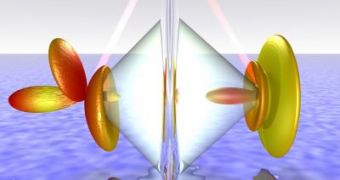Atoms are formed of a positively charged nucleus - containing protons and neutrons - and an outer shell of electrons spinning around the nucleus. Now, we know that the nucleus is found in the center of the atom, but individual electrons spinning at high speeds around the nucleus are rather hard to localize, which is why the electron shell is often called electron cloud. The electrons can occupy any position on the respective orbit at any given time.
Localizing electrons in molecules is even harder because when atoms bond together to form a molecule they share their electron clouds, making it almost impossible to tell which electrons belong to each atom. This process is called delocalization. The question is whether or not all the electrons are shared, and if the electrons occupying the orbit closest to the nucleus also participate in the delocalization process.
Lawrence Berkeley National Laboratory researchers may have partially resolved the paradox in an experiment carried at the Advanced Light Source facility, which had the role of removing the closest electron to the nucleus from an atom inside a nitrogen molecule. By observing the behavior of the electron, Berkeley scientists then approximated which of the two atoms - of the nitrogen molecule - it came from.
When nitrogen molecules are exposed to high energy light generated by a synchrotron radiation source, they eject one electron leaving behind a hole - positive charge - in one of the two atoms. This electron is called a photo-electron. The molecule then immediately ejects a second electron, called an Auger electron. The two are in an entangled state, thus the Auger electron can be used to reveal which of the atoms the first electron came from.
Entanglement was predicted by quantum theory, and is the basic phenomenon quantum cryptography and 'quantum teleportation' rely on. When he first encountered it, Einstein called entanglement 'spooky action at a distance'.
This is the first experiment to prove that entanglement also works in electrons - it was previously observed only in twin photons. Professor Reinhardt D?rner, leader of the study, revealed that if the ejected electron is identified as coming from one of the atoms, then the Auger electron would have originated in each of the two atoms.
However, as with all things in quantum mechanics, electron localization could sometimes prove impossible due to the random nature of quantum theory.

 14 DAY TRIAL //
14 DAY TRIAL //